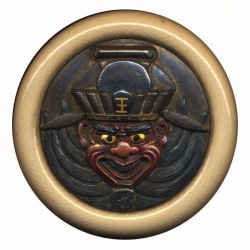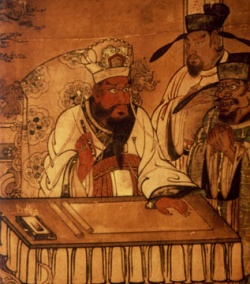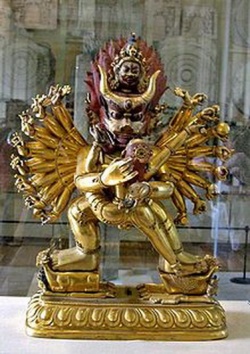Yama (Buddhism and Chinese mythology)
In Buddhist mythology, Yama (Sanskrit: यम) is a dharmapala (wrathful god) said to judge the dead and preside over the Narakas ("Hells" or "Purgatories") and the cycle of rebirth.
Although ultimately based on the god Yama of the Hindu Vedas, the Buddhist Yama has developed different myths and different functions from the Hindu deity. He has also spread far more widely and is known in every country where Buddhism is practiced, including China and Japan.
Yama in Theravāda Buddhism
In Hinduism, Yama was the son of sun god Surya[citation needed] and presided over Naraka, the Hindu underworld. Adopted into Buddhism, Yama's exact role is fairly vague in canonical texts, but is clearer in extra-canonical texts and popular beliefs, although these are not always consistent with Buddhist philosophy.
In the Pali canon, the Buddha states that a person who has ill-treated their parents, ascetics, holy persons, or elders is taken upon his death to Yama. Yama then asks the ignoble person if he ever considered his own ill conduct in light of birth, aging, sickness, worldly retribution and death (mrtyu). In response to Yama's questions, such an ignoble person repeatedly answers that he failed to consider the kammic consequences of his reprehensible actions and as a result is sent to a brutal hell "so long as that evil action has not exhausted its result."
In the Pali apocrypha, the scholar Buddhaghosa's commentary to the Majjhima Nikaya describes Yama as a vimānapeta (विमानापता), a "being in a mixed state", sometimes enjoying celestial comforts and at other times punished for the fruits of his karma. However, Buddhaghosa considered his rule as a king to be just.
Modern Theravādin countries portray Yama sending old age, disease, punishments, and other calamities among humans as warnings to behave well. At death, they are summoned before Yama, who examines their character and dispatches them to their appropriate rebirth, whether to earth or to one of the heavens or hells. Sometimes there are thought to be two or four Yamas, each presiding over a distinct Hell.
Yama in Chinese, Korean, and Japanese mythology
In Chinese mythology, Yan (Chinese: t: 閻, s: 阎, p: Yán) is the god of death and the ruler of Diyu. From Vedic Sanskrit Yama Rājā (यम राज, "King Yama"), he is also known as Yanluowang (t: 閻羅王, s: 阎罗王, p: Yánluówáng, w: Yen2-lo2-wang2 and t: 閻, s: 阎, p: Yán). In both ancient and modern times, Yan is portrayed as a large man with a scowling red face, bulging eyes, and a long beard. He wears traditional robes and a judge's cap or a crown which bears the character 王, "king." He typically appears on Chinese hell money in the position reserved for political figures on regular currency.
Yan is not only the ruler but also the judge of the underworld and passes judgment on all the dead. He always appears in a male form, and his minions include a judge who holds in his hands a brush and a book listing every soul and the allotted death date for every life. Ox-Head and Horse-Face, the fearsome guardians of hell, bring the newly dead, one by one, before Yan for judgement. Men or women with merit will be rewarded good future lives or even revival in their previous life. Men or women who committed misdeeds will be sentenced to torture or miserable future lives. In some versions, Yan divides Diyu into eight, ten, or eighteen courts each ruled by a Yama King, such as King Chujiang, who rules the court reserved for thieves and murderers.
The spirits of the dead, on being judged by Yan, are supposed to either pass through a term of enjoyment in a region midway between the earth and the heaven of the gods or to undergo their measure of punishment in the nether world. Neither location is permanent and after a time, they return to Earth in new bodies.
"Yan" was sometimes considered to be a position in the celestial hierarchy, rather than an individual. There were said to be cases in which an honest mortal was rewarded the post of Yan and served as the judge and ruler of the underworld.[citation needed]
These Chinese beliefs subsequently spread to Korea and Japan. In Japan, he is called Emma (閻魔, prev. "Yemma"), King Emma (閻魔王, Emma-ō), and Great King Emma (閻魔大王, Emma Dai-Ō). In Korea, Yan is known as Yeomna (염라) and Great King Yeomna (염라대왕, Yŏmna Daewang). In Vietnam these Buddhist deities are known as Diêm vương and are venerated as a council of all ten kings who oversee underworld realm of địa ngục.
Yama in Tibetan Buddhism
In Tibetan Buddhism, Shinje (Tibetan: གཤིན་རྗེ་, Gshin.rje) is both regarded with horror as the prime mover of the cycle of death and rebirth and revered as a guardian of spiritual practice. In the popular mandala of the Bhavacakra, all of the realms of life are depicted between the jaws or in the arms of a monstrous Shinje. Shinje is sometimes shown with a consort, Yami, and sometimes pursued by Yamantaka ("Yama-Death"):
- A holy man was told that if he meditated for the next 50 years, he would achieve enlightenment. The holy man meditated in a cave for 49 years, 11 months, and 29 days, until he was interrupted by two thieves who broke in with a stolen bull. After beheading the bull in front of the hermit, they ignored his requests to be spared for but a few minutes and beheaded him as well. In his near-enlightened fury, this holy man became Yama, the god of Death, took the bull's head for his own, and killed the two thieves, drinking their blood from cups made of their skulls. Still enraged, Yama decided to kill everyone in Tibet. The people of Tibet, fearing for their lives, prayed to the bodhisattva Manjushri, who took up their cause. He transformed himself into Yamantaka, similar to Yama but ten times more powerful and horrific. In their battle, everywhere Yama turned, he found infinite versions of himself. Manjushri as Yamantaka defeated Yama and turned him into a protector of Buddhism. He is generally considered a wrathful deity.[citation needed]
Yama in culture

- "Enma face" (閻魔顔 Enma-gao?) is an idiom used to describe someone with a fearsome face.
- "If you lie, Lord Enma will pull out your tongue" (嘘をつけばと閻魔さまに舌を抜かれる?) is a superstition often told to scare children into telling the truth.
- A Japanese kotowaza states "When borrowing, the face of a jizō; when repaying (a loan), the face of Enma" (借りる時の地蔵顔、返す時の閻魔顔?). Jizō is typically portrayed with a serene, happy expression whereas Enma is typically portrayed with a thunderous, furious expression. The kotowaza alludes to changes in people's behaviour for selfish reasons depending on their circumstances.
- Saimyō-ji, a Shingi Shingon Buddhist temple in Mashiko, Tochigi, Tochigi Prefecture, Japan, is the only temple where one can see a statue of a laughing Enma.

